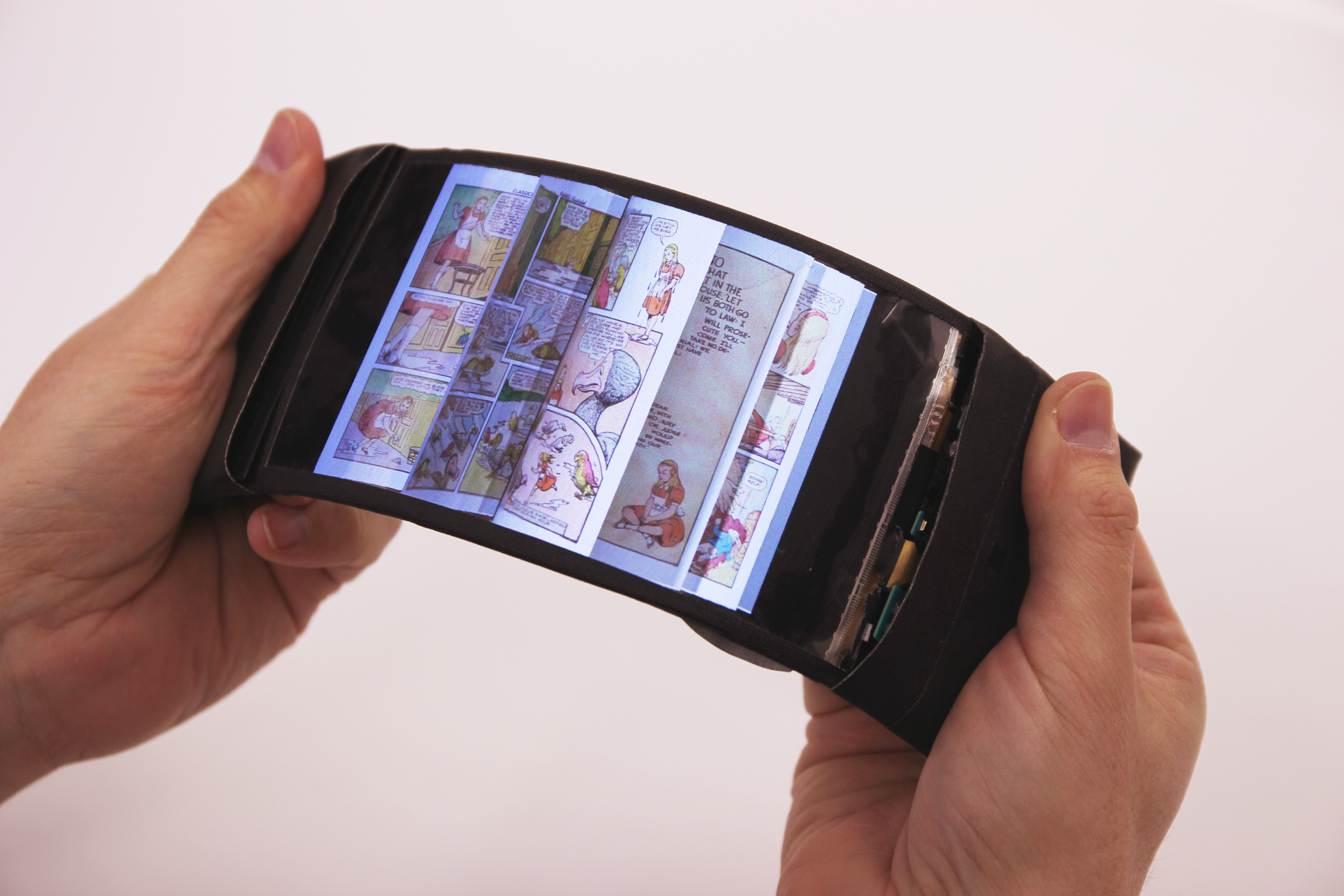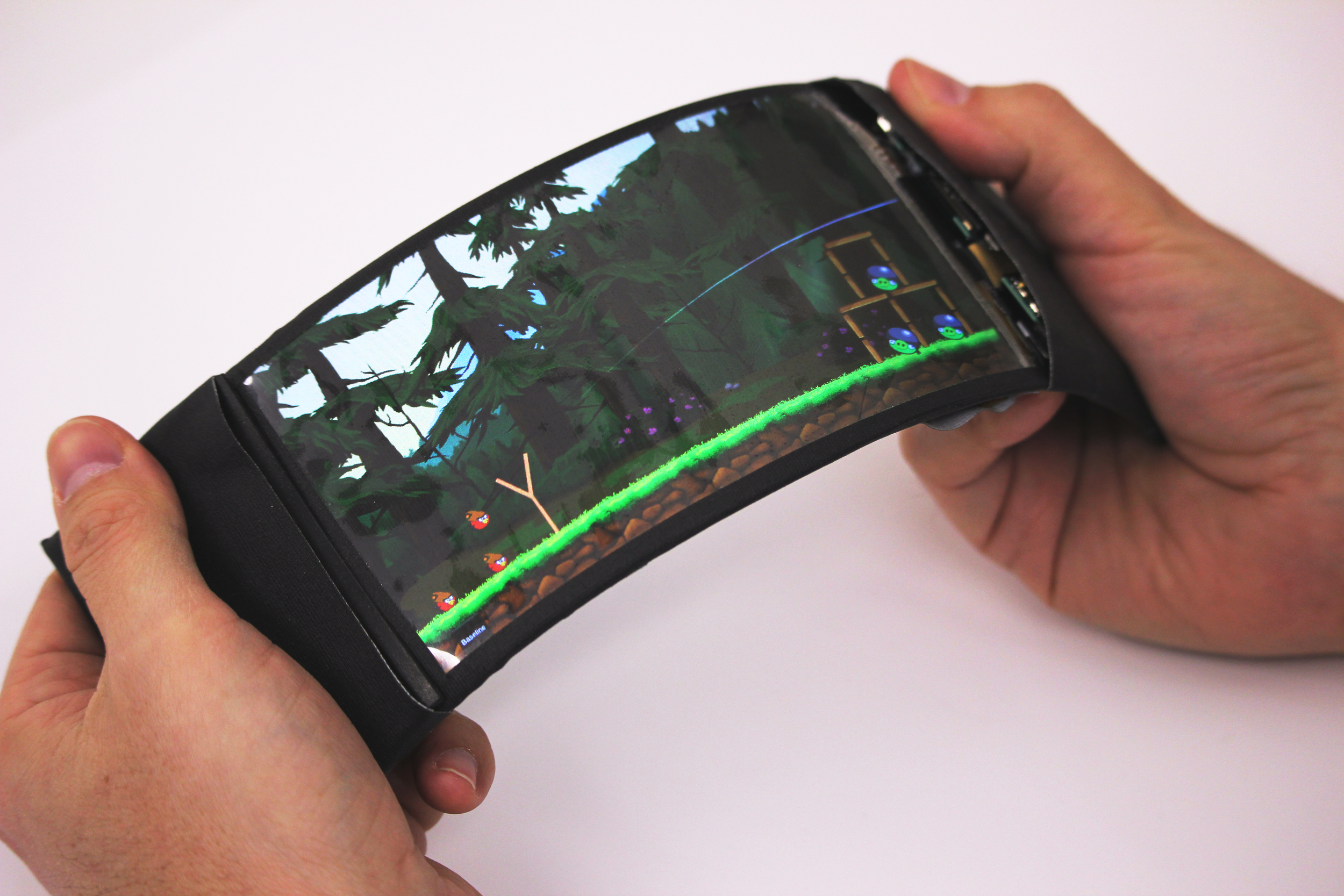Queen’s University’s Human Media Lab to unveil world’s first wireless flexible smartphone; simulates feeling of navigating pages via haptic bend input
KINGSTON - Researchers at Queen’s University’s Human Media Lab have developed the world’s first full-colour, high-resolution and wireless flexible smartphone to combine multitouch with bend input. The phone, which they have named ReFlex, allows users to experience physical tactile feedback when interacting with their apps through bend gestures.
“This represents a completely new way of physical interaction with flexible smartphones” says Roel Vertegaal (School of Computing), director of the Human Media Lab at Queen’s University.
“When this smartphone is bent down on the right, pages flip through the fingers from right to left, just like they would in a book. More extreme bends speed up the page flips. Users can feel the sensation of the page moving through their fingertips via a detailed vibration of the phone. This allows eyes-free navigation, making it easier for users to keep track of where they are in a document.”
ReFlex is based on a high definition 720p LG Display Flexible OLED touch screen powered by an Android 4.4 “KitKat” board mounted to the side of the display. Bend sensors behind the display sense the force with which a user bends the screen, which is made available to apps for use as input. ReFlex also features a voice coil that allows the phone to simulate forces and friction through highly detailed vibrations of the display. Combined with the passive force feedback felt when bending the display, this allows for a highly realistic simulation of physical forces when interacting with virtual objects.
“This allows for the most accurate physical simulation of interacting with virtual data possible on a smartphone today,” says Dr. Vertegaal. “When a user plays the “Angry Birds” game with ReFlex, they bend the screen to stretch the sling shot. As the rubber band expands, users experience vibrations that simulate those of a real stretching rubber band. When released, the band snaps, sending a jolt through the phone and sending the bird flying across the screen.”
Dr. Vertegaal thinks bendable, flexible smartphones will be in the hands of consumers within five years. Queen’s researchers will unveil the ReFlex prototype at the tenth anniversary Conference on Tangible Embedded and Embodied Interaction (TEI) conference in Eindhoven, The Netherlands on February 17th. The annual forum is the world’s premier conference on tangible human-computer interaction.
This research was support by Immersion Canada, Inc. and the Natural Sciences and Engineering Research Council of Canada (NSERC).
Media Footage
High resolution photographs of ReFlex are available rights-free by clicking the thumbnails below. Please include a photo credit to Human Media Lab.
References
Strohmeier, P., Burstyn, J., Carrascal, J-P, Levesque, V. and Vertegaal, R. ReFlex: A Flexible Smartphone with Active Haptic Feedback for Bend Input. In Proceedings of ACM TEI'16 Conference on Tangible, Embedded and Embodied Interaction, ACM Press, 2016.
About the Human Media Lab
he Human Media Lab (HML) at Queen’s University is one of Canada's premier Human-Computer Interaction (HCI) laboratories. Inventions include ubiquitous eye tracking sensors, eye tracking TVs and cellphones, PaperPhone, the world’s first flexible phone, PaperTab, the world’s first flexible iPad and TeleHuman, the world’s first pseudo-holographic teleconferencing system. HML is directed by Dr. Roel Vertegaal, Professor of HCI at Queen's University's School of Computing, as well as a number of graduate and undergraduate students with computing, design, psychology and engineering backgrounds.
Contact
Chris Armes
Communications Officer, Media Relations
613-533-6000 ext. 77513
chris.armes@queensu.ca


